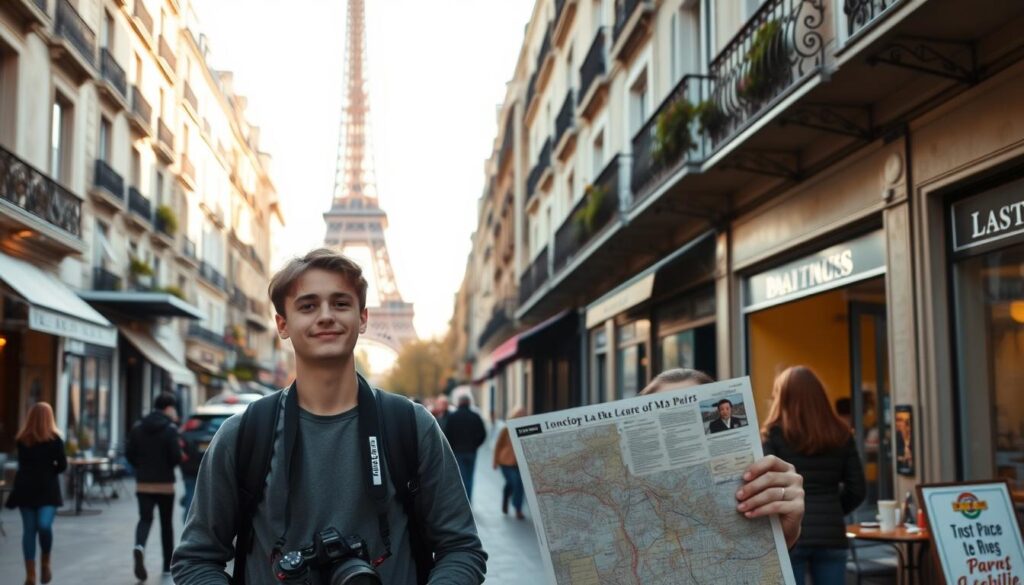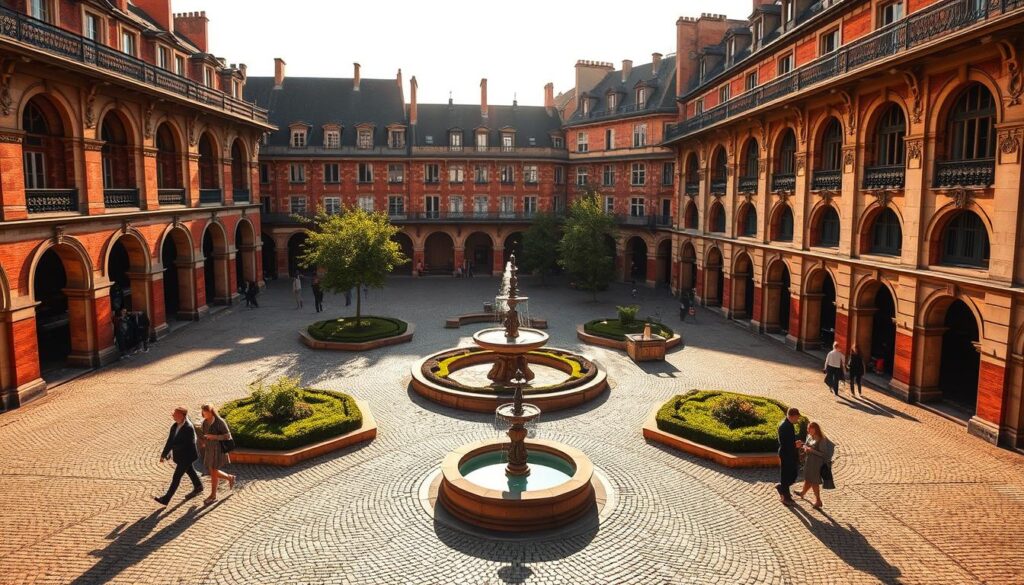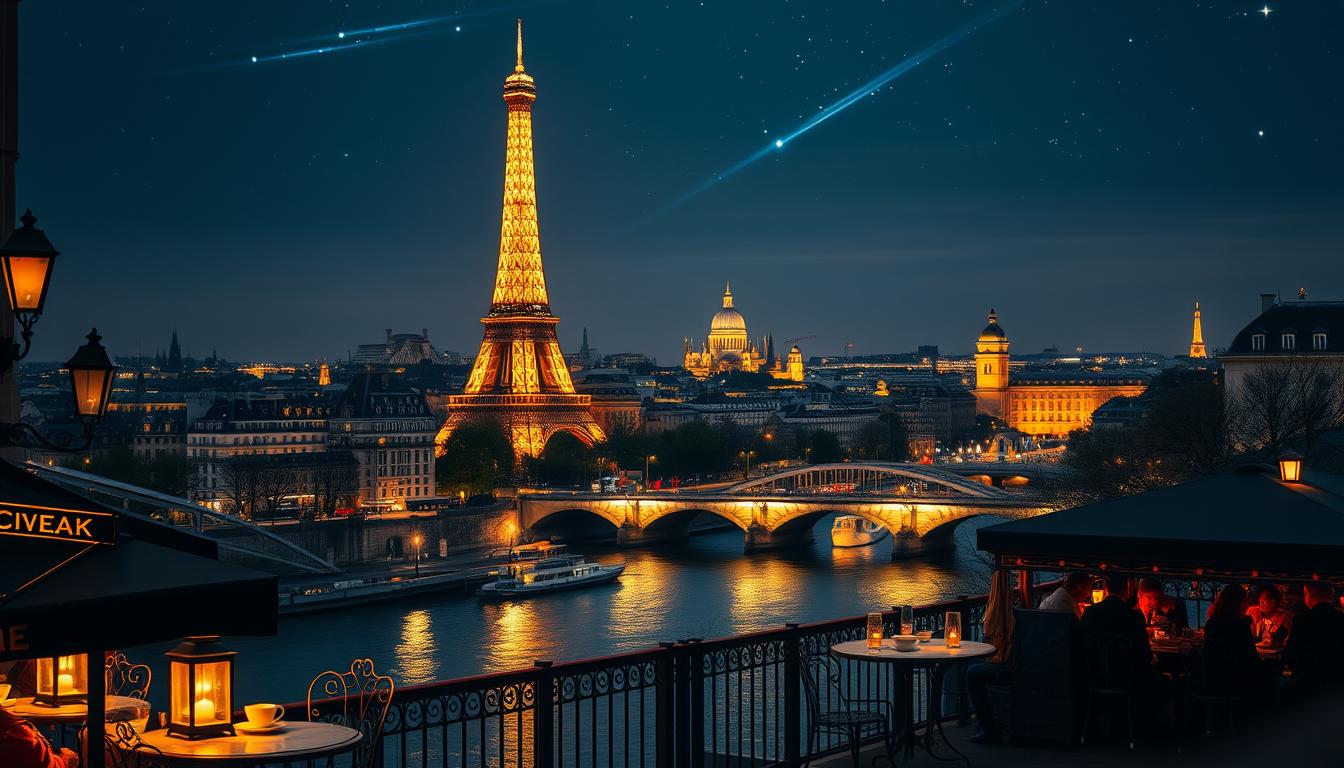Paris Travel Guide: Explore the City of Light
Did you know the French capital sees over 30 million visitors annually? That’s more than the entire population of Australia! This iconic metropolis blends timeless elegance with modern energy, offering endless discoveries for every traveler.
From cobblestone streets lined with patisseries to awe-inspiring landmarks like the Eiffel Tower, this city crafts moments that linger long after you leave. Our guide focuses on practical magic—helping you uncover both famous sights and neighborhood gems locals adore.
Planning your adventure doesn’t need to feel overwhelming. We’ll share tips on avoiding crowds, savoring authentic croissants, and finding secret courtyards bursting with charm. Whether it’s your first time or fifth, there’s always something new glowing in the City of Light.
Key Takeaways
- Discover iconic landmarks and lesser-known treasures
- Learn crowd-beating strategies for popular attractions
- Find authentic dining spots beyond tourist hotspots
- Get seasonal tips to enhance your experience
- Understand public transport shortcuts
- Explore art and history through smart itinerary planning
Introduction to the City of Light
![]()
Imagine wandering through a living storybook where every alley whispers tales of revolution and romance. This capital’s glow comes not just from streetlamps but from centuries of artists, thinkers, and dreamers shaping our world.
What Makes Paris Unique
The city’s 20 arrondissements spiral like a snail shell from its historic heart. This clever design lets you track your location using district numbers – lower numbers mean you’re near the center. You’ll find Gothic cathedrals sharing streets with neon-lit jazz clubs, proving old and new coexist beautifully here.
Locals cherish their neighborhood identities. The Left Bank’s bookshops contrast with the Right Bank’s chic boutiques, yet both sides unite through sidewalk cafés where people-watching becomes an art form. Don’t miss the Haussmann-era buildings – their cream-colored stone and wrought-iron balconies define central Paris’ charm.
Setting the Scene for Your Journey
Pack comfortable shoes – the city’s walkability lets you stumble upon hidden courtyards and vibrant markets. Morning light on the Seine reveals why this place inspired Monet and Hemingway. For quick orientation:
| Left Bank Features | Right Bank Highlights | Central Gems |
|---|---|---|
| Bohemian vibes | Luxury shopping | Historic palaces |
| Literary cafés | Grand museums | Medieval streets |
| University quarter | Opera district | Iconic bridges |
Evening transforms the city into its City of Light persona – golden illumination makes landmarks glow like jewelry. Remember, the best experiences often happen between guidebook pages – in bakeries selling crusty baguettes or parks where locals picnic with fromage.
Iconic Landmarks and Must-See Attractions
![]()
Iron lattices kiss the clouds while marble halls whisper stories of emperors and artists. This city’s skyline blends architectural marvels with quiet sanctuaries where light dances through colored glass. Let’s explore both showstoppers and secret spots that define its creative spirit.
Architectural Giants
The Eiffel Tower isn’t just for photos – arrive at sunset to watch its hourly sparkle show. For panoramic views, climb the Arc de Triomphe instead. You’ll see twelve radiating avenues and the tower itself framed by Haussmann rooftops.
Creative Treasures Beyond Crowds
While the Louvre’s Mona Lisa draws millions, these alternatives offer breathing room:
| Main Attractions | Hidden Gems | Best For |
|---|---|---|
| Louvre Museum | Orangerie Museum | Iconic art collection |
| Eiffel Tower | Rodin Garden | Sculpture lovers |
| Arc de Triomphe | Sainte-Chapelle | Stained glass marvels |
Notre-Dame’s restored spire gleams anew after five years of meticulous work. Nearby, Sainte-Chapelle’s 1,113 biblical scenes in stained glass create rainbow-lit aisles. Art enthusiasts should head to Musée d’Orsay – its Impressionist collection fills a gorgeous former train station.
Pro tip: Book Rodin Museum tickets online to skip lines. Their rose gardens make perfect picnic spots between bronze masterpieces. For modern art fans, the Pompidou Center’s rooftop rivals the tower’s vistas.
Paris Travel Guide for First-Time Visitors

Stepping into this luminous metropolis for the first time feels like unlocking a treasure chest – dazzling but slightly overwhelming. Let’s turn those jitters into confidence with smart strategies that help you navigate like a pro.
Essential Tips for Navigating Paris
Flying from the US? Your first day demands gentleness. Hydrate like it’s your job and stroll rather than sprint. The Seine’s morning glow reveals the best time to see landmarks crowd-free – aim for sunrise walks near Notre-Dame.
Cash remains king at patisseries and flower markets. Keep €10-20 bills handy – many cafés prefer coins for espresso orders. Contact your bank about foreign transaction fees. Bank of America users get fee-free ATM access at BNP Paribas locations citywide.
| Morning Advantage | Cash Tips | Zone Strategy |
|---|---|---|
| Quiet streets | Small bills | Walkable areas |
| Golden hour photos | Coin purse | Metro backups |
| Fresh pastries | Notify bank | Local discoveries |
Cluster your trip activities by neighborhood. Day one could mean exploring Montmartre’s hills, saving the Louvre for later. Locals love when visitors take time to linger – that corner bistro might become your favorite memory.
Remember: Getting lost here often leads to magic. If fatigue hits, hop on metro line 4 – its circular route helps reorient you. The city rewards those who balance planning with spontaneity.
Exploring Paris Neighborhoods and Arrondissements

The Seine River acts as both divider and connector, splitting the city into distinct halves while offering bridges that stitch them together. Each bank reveals different chapters of the city’s story – the Left Bank’s scholarly energy contrasts with the Right Bank’s regal grandeur. To truly explore Paris, you’ll want to wander both sides like a local historian with a sweet tooth for discovery.
Central Paris and the Historic Arrondissements
Start in the Marais, where history lives in every cobblestone. Sundays transform this area into a buzzing hive – artists sketch near Place des Vosges’ manicured gardens while vintage shops tempt browsers. Don’t miss Rue des Rosiers, where delis serving golden falafel nod to the neighborhood’s Jewish heritage.
Discovering the Left and Right Banks
The Latin Quarter on the Left Bank feels like stepping into a Renaissance painting. Students debate philosophy near the Sorbonne, while Musée d’Orsay’s clock towers watch over Impressionist masterpieces. Cross the river to the Right Bank for Haussmann’s grand boulevards leading to the Louvre’s glass pyramid.
| Left Bank Highlights | Right Bank Treasures |
|---|---|
| Bohemian bookstores | Luxury shopping streets |
| Art nouveau cafés | Imperial palaces |
| University spirit | Opera House grandeur |
Smart explorers divide days by areas – cluster Marais wanderings with Île Saint-Louis ice cream stops. The 6th arrondissement’s Saint-Germain-des-Prés offers chic boutiques, while Montmartre’s hills reward climbers with panoramic views. Every street here tells two stories: one etched in stone, another written in espresso steam.
Experiencing Parisian Culture and Cuisine
Baguette crumbs dot sunlit tables as laughter spills from corner bistros – this is where the city’s heartbeat syncs with clinking glassware. To savor authentic flavors means embracing both quick bites and leisurely meals, where every bite tells a story.
Café Rituals and Market Treasures
Stand at a zinc-topped bar for €2 espresso, or claim a terrace chair for hours of people-watching. Locals never rush these moments – your table stays yours until requested. For flaky perfection, Du Pain et Des Idées crafts snail-shaped pastries bursting with pistachio or chocolate.
Global Bites and Shared Plates
Street eats here go beyond crepes. Join the queue at L’as Du Fallafel for crispy chickpea gems wrapped in warm pita. Thursday markets near Bastille burst with ripe cheeses and sun-warmed peaches – perfect for picnics in Luxembourg gardens.
Summer evenings transform meals into open-air celebrations. Share carafes of rosé at corner restaurants, or grab rotisserie chicken from a neighborhood shop. Remember: dining here isn’t just about food – it’s the art of savoring life’s layers.
FAQ
What’s the best way to explore the city for the first time?
How do I avoid crowds at popular spots like the Louvre?
Which neighborhoods offer authentic local vibes?
What’s a must-try dish beyond croissants?
When is the ideal time to visit for good weather?
Are day trips worth it from the capital?
How do I use public transportation efficiently?

Adam Peter is a finance, travel, and automotive writer with over a decade of experience. He creates clear, practical content to help readers manage their money, explore the world with confidence, and make informed decisions about cars and travel gear. His work blends expert insight with real-world usefulness.




